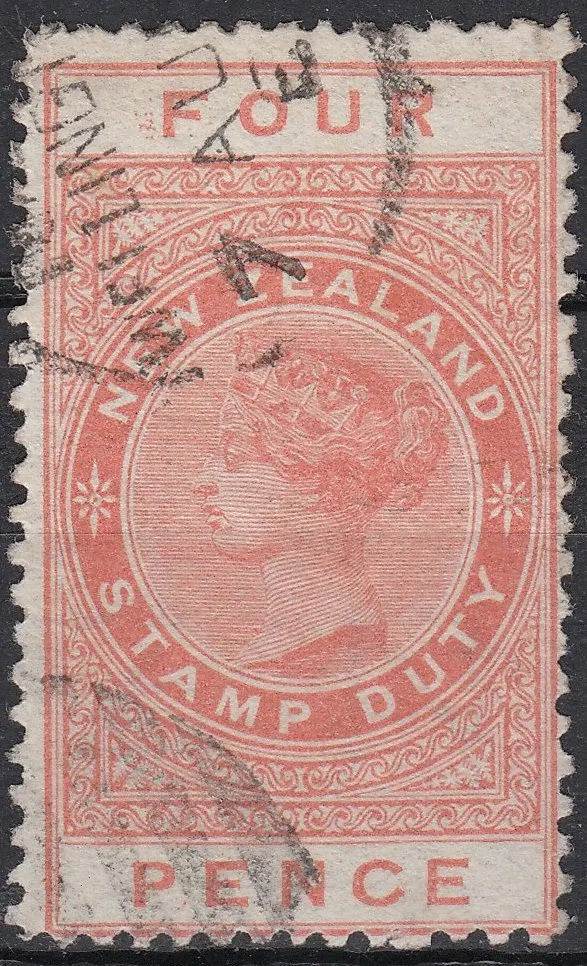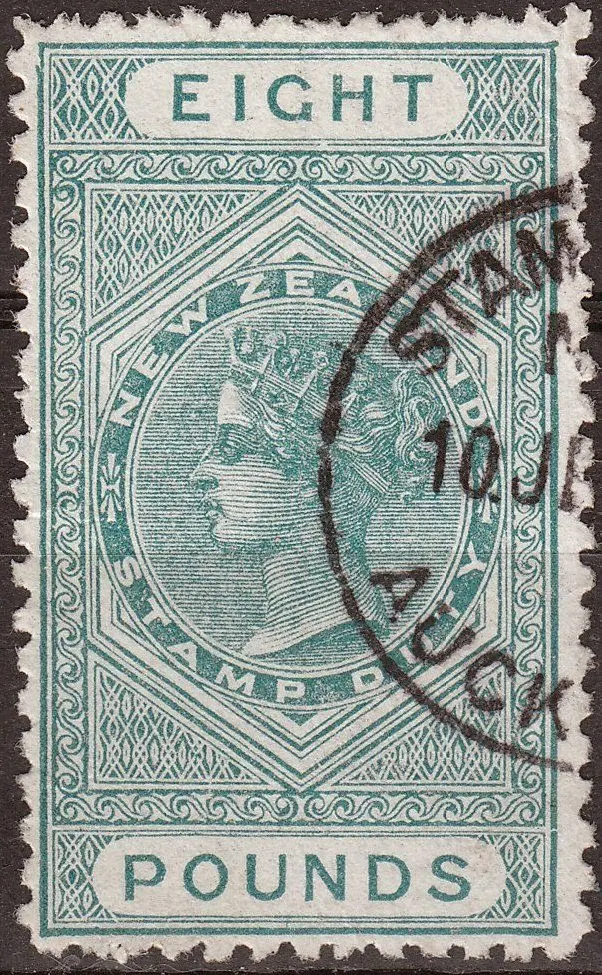1880 Queen Victoria Long-Type Postal Fiscals.
The 1880 Queen Victoria Long types are by far the most diverse set of revenue stamps printed in New Zealand. 14 different printings were made over the 51-year history of the issue (even long after Queen Victoria had died!) with different papers, watermarks and perforations evident between each issue. This, combined with the wide range of values, from 4d to 1000 pounds, makes this an exceptionally interesting set to study.
A History of the Issue.
By 1878 the die II revenue printing plates were beginning to wear. This resulted in several options for their replacement being considered. In 1878 and the following years, several important decisions were made by the New Zealand government. These resulted in major changes to both postage and revenue stamp production.
1878
It was decided that for the 1d denomination, most in demand of the revenue stamps, a new stamp of a completely different design would be introduced. Since this stamp would be used on many different documents a more convenient size was also considered. This resulted in the introduction of a smaller sized stamp based upon the British 1d Inland Revenue stamp. The design also reflected some of the current stamps in New Zealand's 1882 Second Side-Faced issue. Initially, this stamp was printed in lilac (15th June 1878) but due to the stamp's faded appearance was later printed in blue (from 14th December 1878).
1878 - 1d Lilac. 1878 - 1d Blue.
1880
Finally, a design was settled on for the rest of the new 'Revenue' issue. This was very similar to the previous stamp duty/revenue issues. (See my post, Queen Victoria Fiscal Stamps- Part One) New electrotype plates were made for the whole revenue series from dies engraved by W.R.Bock. As I said, the design was very similar to that of the earlier series, however, production was done in a different way. For the lower values a separate plate was made for each denomination with the value incorporated, but for the higher values a master plate with the word POUNDS in the lower panel, then the value in words was printed from type in the top panel. As the 1d was already provided for, the new plates covered denominations from 4d upwards.
4d - Orange. 8d - Green. 1/- Pink.
In the lower values above, plates were produced for each denomination so the type and colour in the text of the top and bottom panels appear the same as the domination at the bottom.
£8 - Green. £30 - Red/Brown. £800 - Bronze-Green.
In these three high values, the plate is the same but the value (number in the top panel) has been changed. If you look closely you will notice that the type and colour vary slightly with the word 'Pound' in the bottom panel.
Authorisation for Postage - 1882
When the need for higher value postage stamps was raised, it was decided that postage and revenue stamps could be used for either purpose. The intention was that postage stamps should also be used for low-value revenue purposes using a new series of stamps was placed on sale inscribed Postage and Revenue (the Second Side-Faces).
The authorisation of revenue stamps to be able to be used for postal purposes was also to help cover a temporary shortage in postage stamps due to delays in delivery of the 1882 Second Sideface issue. This took the form of a February Advertisement in local newspapers authorising the 1d value for postal purposes, and the 22 April 1882 memo to Post Offices authorising all duty stamps for postal use. Genuine postally used examples from this period are rare and collectors should be aware that many fraudulent examples exist. The only safe way to guarantee genuine postal use is on a cover.
QV Fiscal Stamps Commonly Used for Postage.
While Fiscal stamps were obviously intended primarily for fiscal purposes, early legislation allowed them to be used for postage. The 1898 Pictorials had two and five shilling stamps which were used for parcel postage, and the 1926 Admirals had two and three shilling stamps but for the rest of the period between 1882 and 1926, higher postage rates were more often met using fiscal stamps.
The difficulty is knowing which values to include and which to exclude from a postage stamp collection (or catalogue!). The full set of fiscal stamps go up to one thousand pounds, but even in 1930, postage on a single item would never cost over two pounds. However, bulk postage on a number of items could be paid for by higher value stamps on a receipt form, so this doesn't completely rule out their use. For simplicity, this post will mainly feature those stamps that were postally used on a regular basis. In Part Three of the series, you will find a complete set of all the 1880 Queen Victoria Fiscal Stamps - Page Three.
Below are the values thought to be most commonly used for postage.

 2/- Blue. 2/6 Brown.
2/- Blue. 2/6 Brown.
3/- Mauve. 4/- Orange-Red. 5/- Green.
6/- Rose. 7/- Blue. 8/- Blue.
9/- Orange. 10/- Red. £1 Rose.
The Officials.
Three of the Fiscal stamps were overprinted 'Official' for postal use by government departments. Since the officials were never used for fiscal purposes, there is no difficulty recognising valid postal cancellations on these stamps.
To view all the 'Official stamps produced by New Zealand visit An Official Post.
2/- Blue (Official). 5/- Green (Official). £1 Rose (Official).
Duration of the Issue.
The Queen Victoria Postal Fiscals were issued in 1880 and approved for postal use in 1882. They remained the only high value set until 1931 when the arms type fiscals were introduced, but some QV Fiscals were not withdrawn from sale until 1939.
No alteration was made to the design of the revenue stamps throughout the period of the issue but denominations below 2/- were withdrawn from sale when there were postage stamps to meet any demand. In the same way, it was intended that postal needs for 2/- and upwards should be met by the use of fiscal stamps.
Distinguishing Postally and Fiscally Used Stamps.
"Distinguishing postally and fiscally used stamps can be quite tricky. All stamps with pen cancellations, punched holes or embossing are fiscally used. Stamps should be inspected under ultraviolet light to see if a fiscal pen cancellation has been removed. Embossed designs were frequently employed on documents and attempts to iron these out have been noted in the past. If the stamps have been postmarked, fiscal cancellations give the region while postal cancellations give the individual post office where the mail was cancelled. Simple circular date stamps with no region or place, and circular 'Stamp Duties Dept' date stamps on Arms issues are fiscal cancellations, and if only the outer ring of the cancellation is visible on the stamp it is safest to assume you have a fiscal cancellation."
The text above was taken with permission from the illustrated catalogue of StampsNZ
Much of the information in this post came from NZ Revenues.






.jpg)















Comments
Post a Comment
We appreciate your engagement with our content. To ensure a respectful and constructive community, please take note of the following:
- No Spam, Please: We do not tolerate spammy or promotional comments. Any such comments will be promptly removed.
- Moderation in Place: All comments are moderated to maintain a positive and inclusive environment. Please be patient, as it may take a little time for your comment to appear.
- Sign In with Google: To comment, please sign in using your Google account. This helps us maintain the integrity of our community and allows for better interaction.